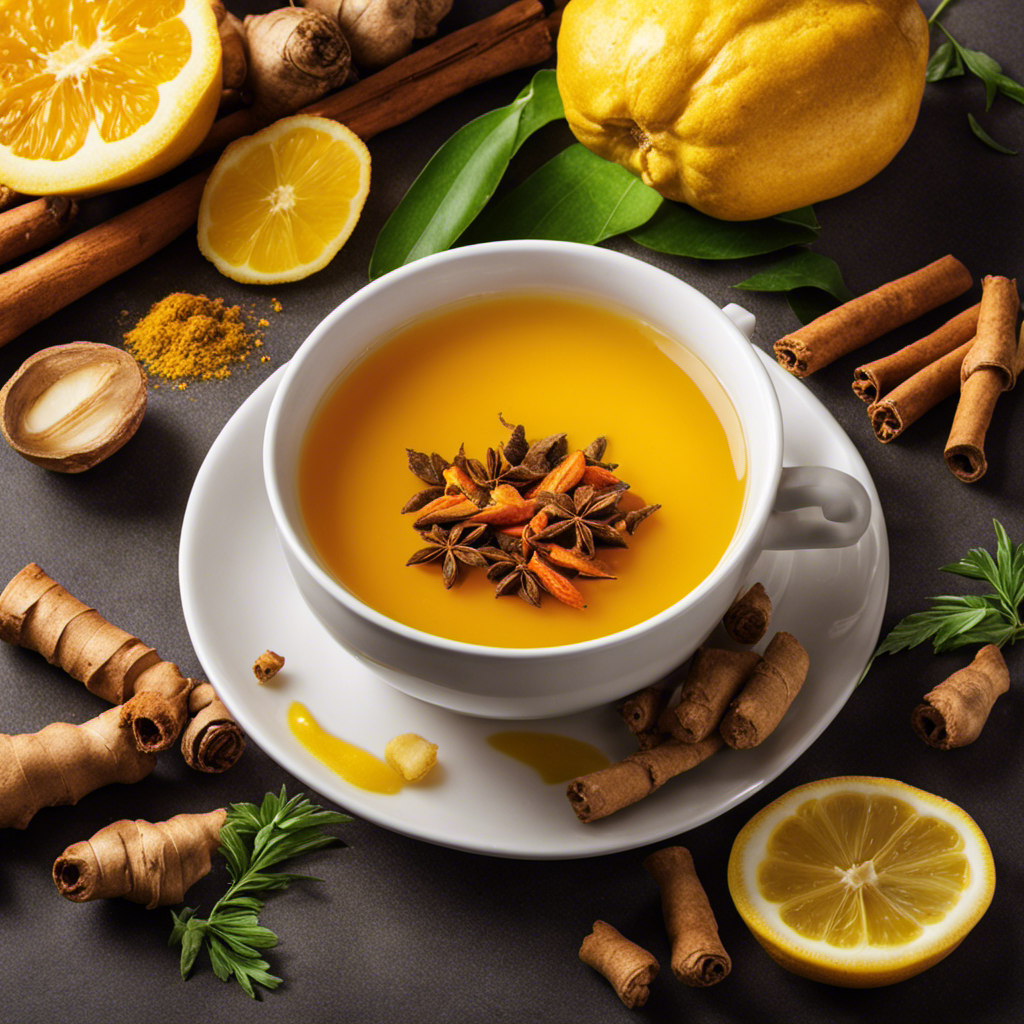Matcha
Irresistible Matcha Brownies Recipe | Easy Baking

Are you looking for a delicious treat that combines the rich flavors of chocolate and the health benefits of matcha? Look no further than matcha brownies!
We recently served these irresistible treats at a charity event, and they were a hit among the guests. The combination of velvety smooth chocolate and the unique earthy taste of matcha creates a truly indulgent dessert.
Our recipe is easy to follow and uses simple ingredients that you likely already have in your pantry. So, whether you’re hosting a gathering or simply want to treat yourself, whip up a batch of matcha brownies and watch as they disappear in no time.
Key Takeaways
- Matcha is a vibrant and exquisite green tea powder made from shade-grown green tea leaves.
- Matcha is packed with antioxidants that help protect the body against free radicals.
- It can boost metabolism and aid in weight management.
- Matcha offers calming and meditative qualities due to the presence of L-theanine.
What Is Matcha
What Is Matcha?
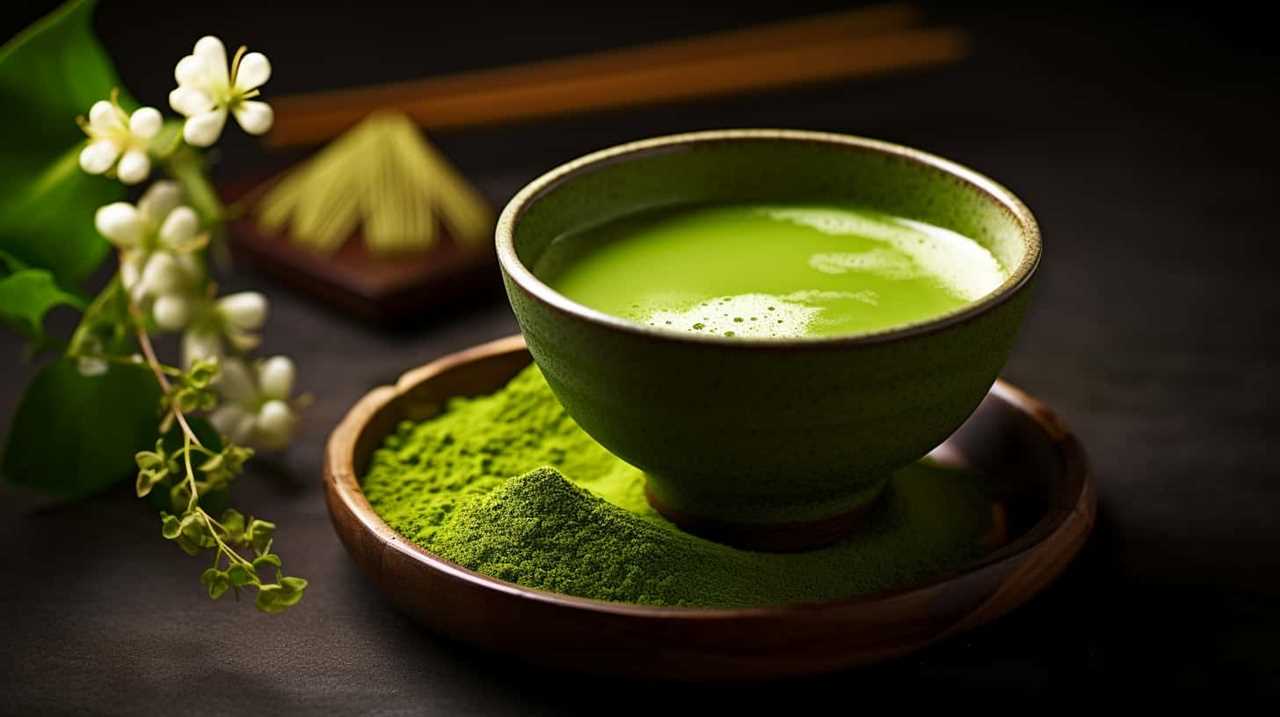
Matcha is a vibrant and exquisite green tea powder that holds a special place in traditional Japanese tea ceremonies. It isn’t your ordinary tea; it’s a finely ground powder made from shade-grown green tea leaves. The process of creating matcha involves carefully cultivating the tea plants to ensure they produce leaves with high chlorophyll content. These leaves are then hand-picked, steamed, dried, and ground into a fine powder.
Matcha comes in different grades, each with its own unique characteristics and uses. The highest grade, ceremonial matcha, is reserved for tea ceremonies and is known for its vibrant green color, smooth texture, and delicate flavor. It’s meticulously prepared and enjoyed for its calming and meditative qualities.
On the other hand, there are culinary matcha grades that are specifically crafted for cooking and baking purposes. These grades are slightly less expensive and possess a stronger flavor, making them perfect for adding a vibrant green hue and a distinct taste to various dishes, such as matcha-infused desserts, smoothies, and even savory dishes.
Now that we understand what matcha is and its role in traditional tea ceremonies, let’s explore the health benefits this remarkable green tea powder offers.
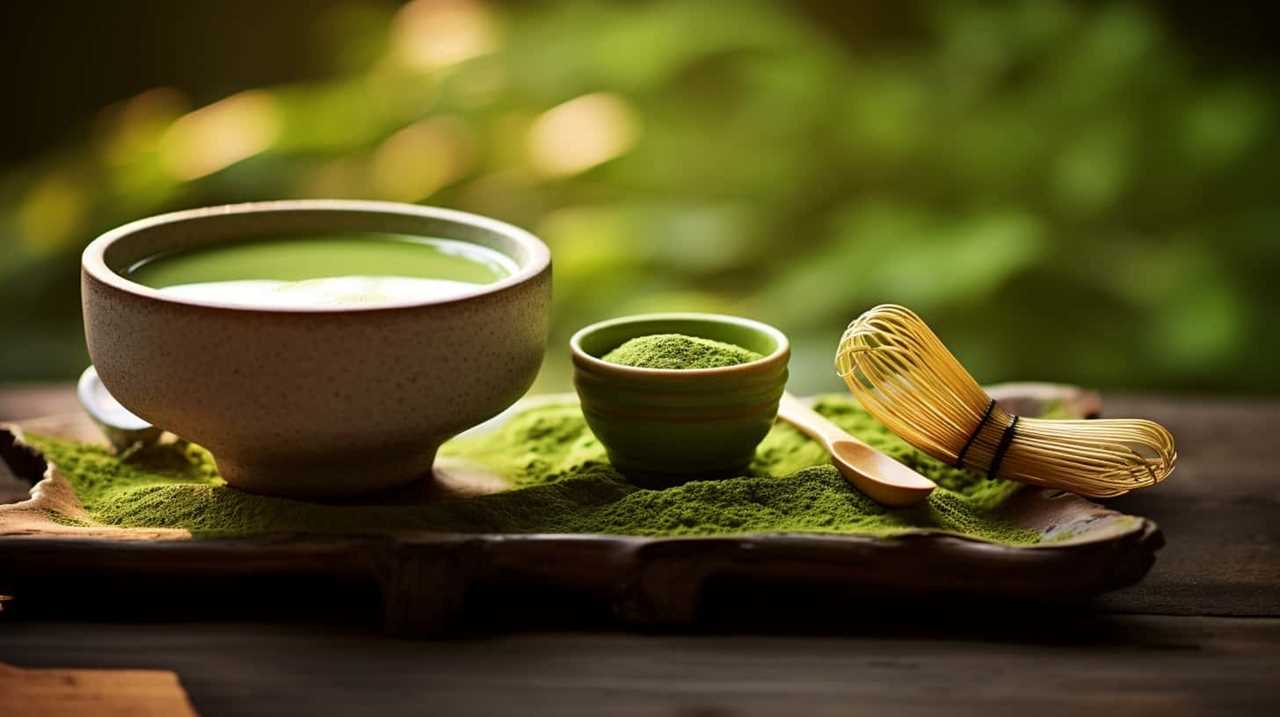
Health Benefits of Matcha
Matcha offers a range of health benefits that make it a nutritious addition to your diet. This vibrant green powdered tea is packed with antioxidants, which help to protect your body against free radicals and reduce the risk of chronic diseases. Matcha is also known to boost metabolism, making it a great choice for those looking to manage their weight.
One popular way to enjoy matcha is in the form of a matcha latte. This creamy and soothing beverage combines the rich flavors of matcha with steamed milk, creating a delicious and healthful treat. Not only does it provide a gentle energy boost, but it also offers a calming effect due to the presence of L-theanine, an amino acid found in matcha.
When compared to regular green tea, matcha stands out for its higher concentration of nutrients. Since matcha is made from whole tea leaves that are ground into a fine powder, you consume the entire leaf and benefit from its full nutritional profile. This includes higher levels of vitamins, minerals, and antioxidants, such as catechins, which are known for their cancer-fighting properties.
Incorporating matcha into your diet is a simple and enjoyable way to reap its many health benefits. Whether you choose to enjoy it as a hot or iced matcha latte, or incorporate it into baked goods like our matcha brownies, you can feel good about nourishing your body with this vibrant and nutrient-rich tea.
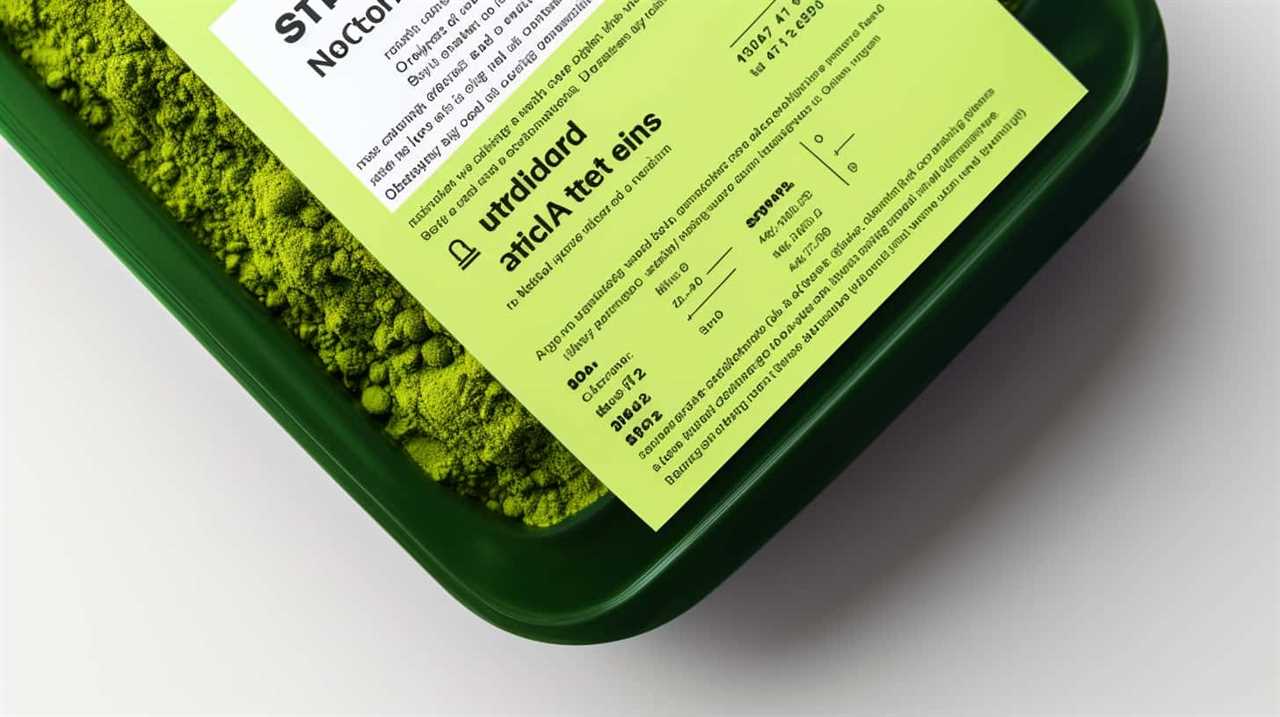
The Perfect Matcha Brownie Recipe
For the ultimate indulgence, we love making a batch of our decadent matcha brownies. These fudgy treats combine the rich flavors of chocolate with the earthy and slightly bitter taste of matcha. Here’s our perfect matcha brownie recipe that will satisfy your sweet tooth and leave you wanting more.
- First, preheat your oven to 350°F and line a square baking pan with parchment paper.
- In a mixing bowl, whisk together 1 cup of all-purpose flour, 1/2 cup of unsweetened cocoa powder, 2 tablespoons of matcha powder, and a pinch of salt.
- In a separate bowl, melt 1/2 cup of butter and mix in 1 cup of sugar until well combined. Then, beat in 2 eggs and 1 teaspoon of vanilla extract.
- Gradually add the dry ingredients to the wet ingredients, mixing until just combined. Be careful not to overmix.
- Fold in 1/2 cup of chocolate chips and pour the batter into the prepared baking pan. Smooth the top with a spatula and bake for 25-30 minutes, or until a toothpick inserted into the center comes out with a few moist crumbs.
These matcha brownies are perfect on their own, but you can also try some delicious flavor combinations to take them to the next level. Serve them with a scoop of vanilla ice cream and a drizzle of chocolate sauce, or sprinkle them with powdered sugar for an elegant touch. The possibilities are endless with matcha desserts, so get creative and enjoy!
Ingredients You’ll Need
Now that we’re ready to whip up some delicious matcha brownies, let’s talk about the key ingredients that will make this treat truly special.
First off, we’ve to mention the health benefits of matcha, packed with antioxidants and known for its calming properties.
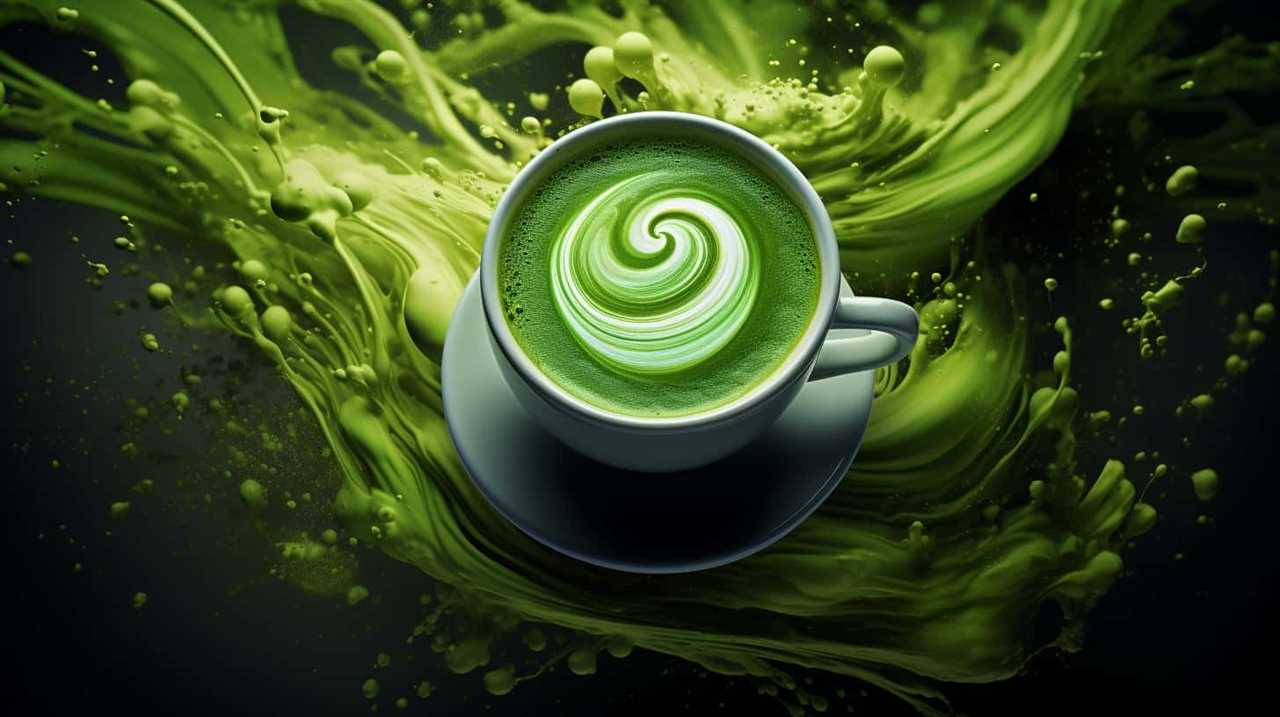
Secondly, the unique flavor profile of matcha, with its earthy and slightly bitter notes, adds a delightful twist to traditional brownies.
Lastly, we can’t forget the versatility of this recipe, as you can easily customize it with your favorite add-ins like nuts, chocolate chips, or even a sprinkle of sea salt.
Get ready for a matcha-infused dessert experience like no other!
Matcha Health Benefits
To make these delicious brownies, we’ll need a few key ingredients that offer numerous health benefits. One of the star ingredients is matcha, a powdered form of green tea known for its vibrant green color and unique flavor. Matcha isn’t only delicious, but it also has several health benefits. Here are some of the ways matcha can improve your well-being:
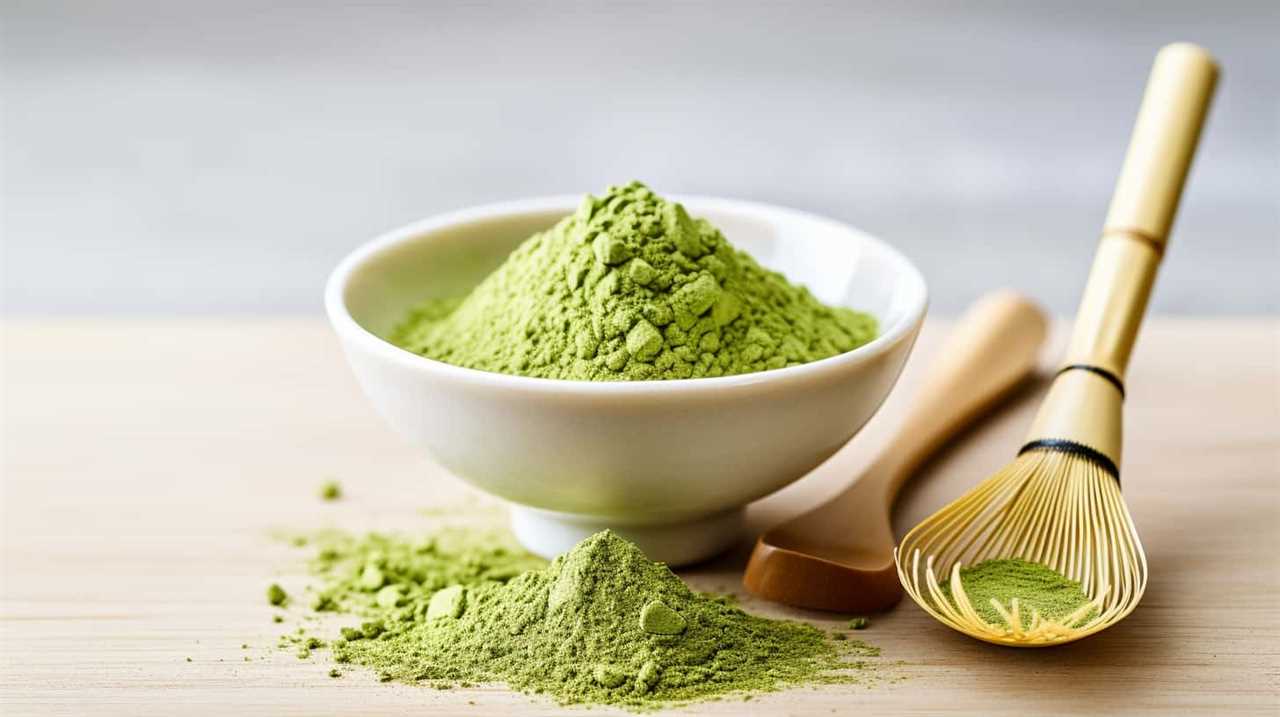
- Matcha and weight loss: Matcha contains catechins, a type of antioxidant that has been shown to boost metabolism and aid in weight loss.
- Matcha and stress reduction: The L-theanine in matcha promotes relaxation and helps reduce stress and anxiety.
- Matcha and detoxification: Matcha is rich in chlorophyll, which helps cleanse the body of toxins and supports liver health.
- Matcha and mental clarity: The combination of caffeine and L-theanine in matcha can enhance focus and concentration.
- Matcha and immune support: Matcha is packed with antioxidants that strengthen the immune system and protect against diseases.
With these incredible health benefits, matcha not only adds a unique flavor profile to our brownies but also contributes to our overall well-being. Now, let’s dive into the delightful taste that awaits us in the next section.
Unique Flavor Profile
We’ll need a few key ingredients to create the unique flavor profile of our matcha brownies. Matcha, a finely ground green tea powder, is the star of the show. It adds a distinct earthy and slightly bitter taste that pairs perfectly with the sweetness of the brownie. But did you know that there are different matcha flavors to choose from? Some have a more vegetal taste, while others are more floral or even fruity. This allows you to experiment and find the flavor that suits your preferences best. Additionally, matcha is not only used in brownies, but also in other desserts like cakes, cookies, and ice cream. Its versatility makes it a popular choice among dessert lovers. To give you a better idea of the ingredients needed, here’s a handy table:
| Ingredient | Quantity | Description |
|---|---|---|
| Matcha powder | 2 tablespoons | Finely ground green tea powder |
| All-purpose flour | 1 cup | Regular flour used in baking |
| Unsalted butter | 1/2 cup | Creamed fat from cow’s milk |
| Sugar | 1 cup | Sweetener derived from sugar cane or sugar beets |
With these ingredients, you’ll be able to create matcha brownies that have a unique and delicious flavor profile.
Easy Recipe Variations
For the different variations of this easy matcha brownie recipe, we often use a variety of additional ingredients to enhance the flavor and texture. Here are some easy recipe variations that you can try:

- Matcha Flavored Frosting: Top your matcha brownies with a creamy and delicious matcha flavored frosting. The combination of the rich matcha flavor and the sweet frosting creates a perfect balance of flavors.
- Matcha Brownie Swirls: Create beautiful swirls in your matcha brownies by adding a swirl of chocolate or vanilla batter. This not only adds visual appeal but also gives a contrasting flavor to the brownies.
- Nuts and Chocolate Chips: Add some crunch and extra richness to your matcha brownies by mixing in some chopped nuts like walnuts or almonds, and a handful of chocolate chips.
- Citrus Zest: To brighten up the flavors of your matcha brownies, try adding some citrus zest like lemon or orange. This adds a refreshing twist to the rich matcha taste.
- Coconut Flakes: For a tropical twist, sprinkle some coconut flakes on top of your matcha brownies. The combination of the earthy matcha and the sweet coconut creates a delightful flavor contrast.
These easy recipe variations will take your matcha brownies to the next level, making them even more enjoyable to serve and share with others.
Step 1: Preparing the Matcha Powder
Now that we’re ready to start making our matcha brownies, let’s first talk about the points we need to consider when preparing the matcha powder.
Matcha powder isn’t only delicious but also packed with health benefits, such as antioxidants and increased energy. Different grades of matcha powder exist, ranging from ceremonial grade to culinary grade, and understanding the differences will help us choose the right one for our brownies.
Lastly, we’ll share some tips for buying matcha powder to ensure we’re getting the best quality for our recipe.
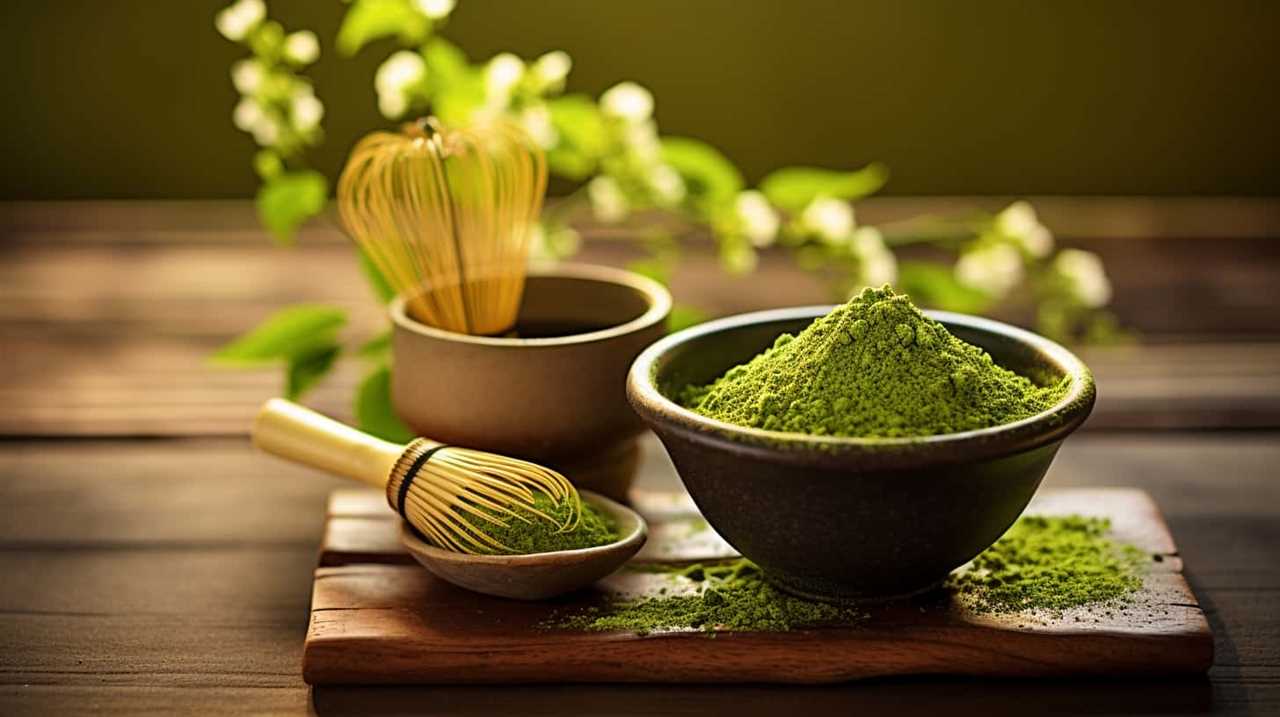
Matcha Powder Benefits
To begin preparing the matcha powder, we can start by sifting it through a fine mesh sieve. This ensures that any clumps or impurities are removed, resulting in a smooth and silky powder.
Now, let’s explore the benefits of matcha powder:
- High in antioxidants: Matcha powder contains a high concentration of antioxidants, which help protect the body against free radicals and promote overall health.
- Boosts metabolism: Matcha has been shown to increase metabolism, making it a great addition to weight loss efforts.
- Provides energy and focus: Matcha contains a unique combination of caffeine and L-theanine, providing a calm and sustained energy boost without the jitters.
- Supports detoxification: Matcha helps the body eliminate toxins and supports liver function.
- Enhances mood and relaxation: The L-theanine in matcha promotes relaxation and helps reduce stress.
Different Matcha Powder Grades
Once we’ve sifted the matcha powder through a fine mesh sieve, we can begin exploring the different grades available.
Matcha powder is categorized into different grades based on the quality of the leaves used and the processing methods.
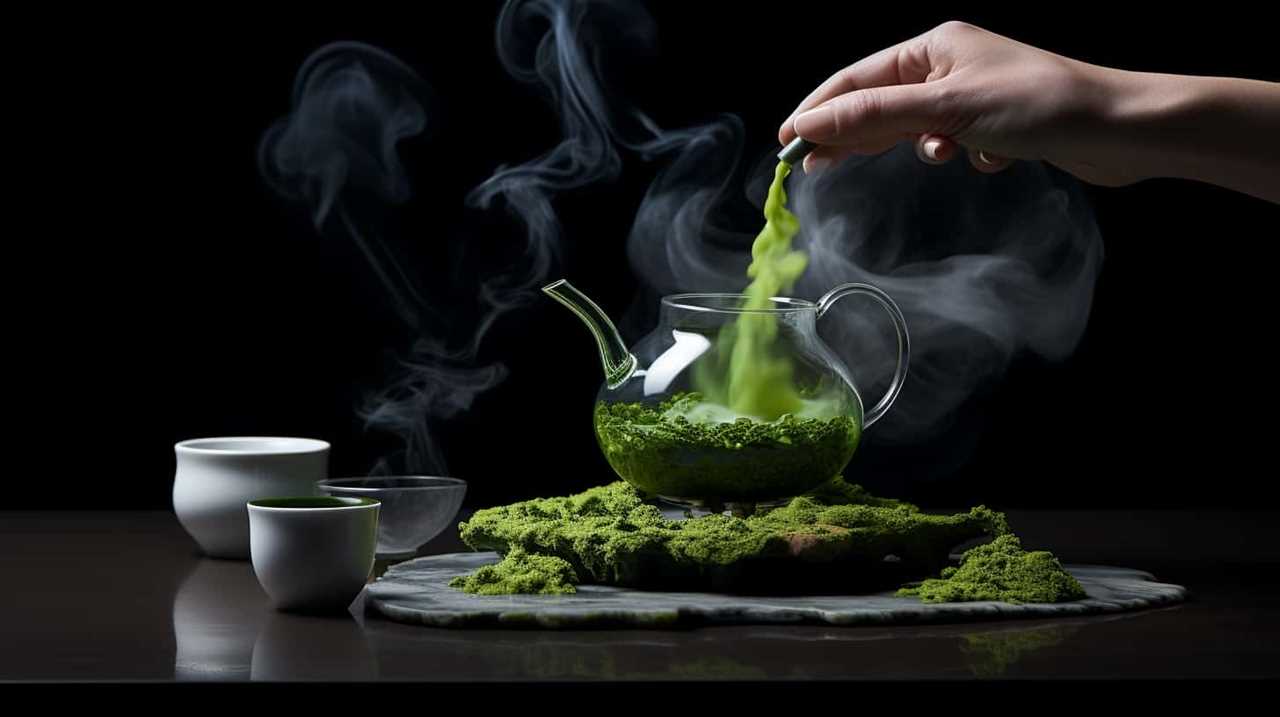
The highest grade is known as ceremonial grade matcha, which is made from young tea leaves that are carefully shaded before harvesting. This grade has a vibrant green color, a smooth texture, and a delicate umami flavor.
On the other hand, culinary grade matcha is more affordable and has a slightly bitter taste. It’s often used in cooking and baking.
Finally, there’s a lower grade called ingredient grade matcha, which is best suited for blending with other ingredients.
Each grade of matcha has its own unique flavor profile, allowing you to choose the one that best suits your preferences and culinary needs.
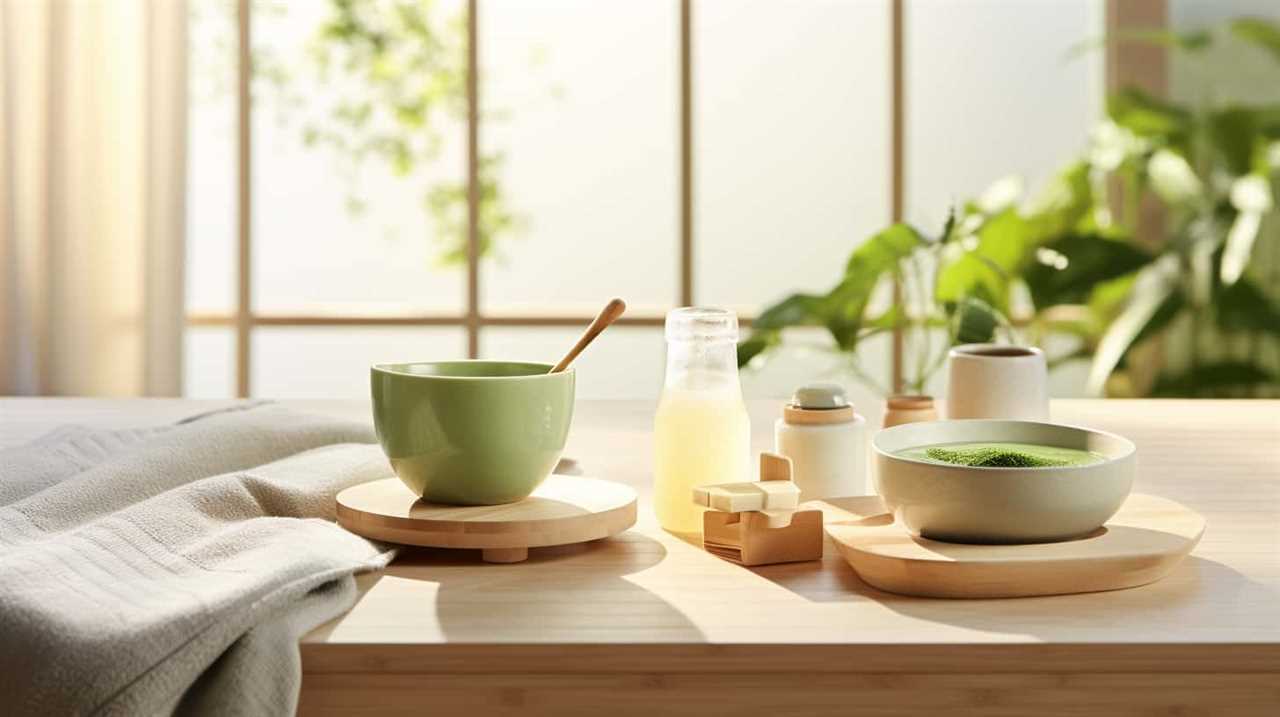
Tips for Buying Matcha
When buying matcha, we start by preparing the matcha powder through a simple process. Here are some tips to help you choose the right matcha and make the most out of its flavor profiles:
- Look for vibrant green color: High-quality matcha should have a bright, vibrant green color.
- Check the origin: Matcha from Japan is considered the best due to its traditional cultivation methods and strict quality control.
- Consider the grade: Matcha comes in various grades, with ceremonial grade being the highest quality and culinary grade being more suitable for cooking and baking.
- Read the packaging: Look for matcha that’s labeled as ‘shade-grown’ or ‘stone-ground’ to ensure the best flavor and texture.
- Smell the matcha: A fresh and vibrant matcha should have a grassy and slightly sweet aroma.
Step 2: Mixing the Wet Ingredients
After gathering all the necessary ingredients, we begin by mixing the wet ingredients for the matcha brownies. This step is crucial as it determines the texture and moisture of the final product. To achieve the perfect balance, we need to pay attention to mixing techniques and wet ingredient ratios.
To begin, we take a large mixing bowl and add the melted butter. The butter adds richness and moisture to the brownies, giving them a heavenly taste. Next, we add in the granulated sugar and whisk until the mixture becomes smooth and creamy. The sugar not only adds sweetness but also helps to create a fudgy texture.
Now it’s time to incorporate the eggs. We crack them into a separate bowl to ensure no shell fragments make their way into the batter. Then, we slowly pour the eggs into the butter-sugar mixture, whisking continuously. This helps to evenly distribute the eggs and create a smooth batter.
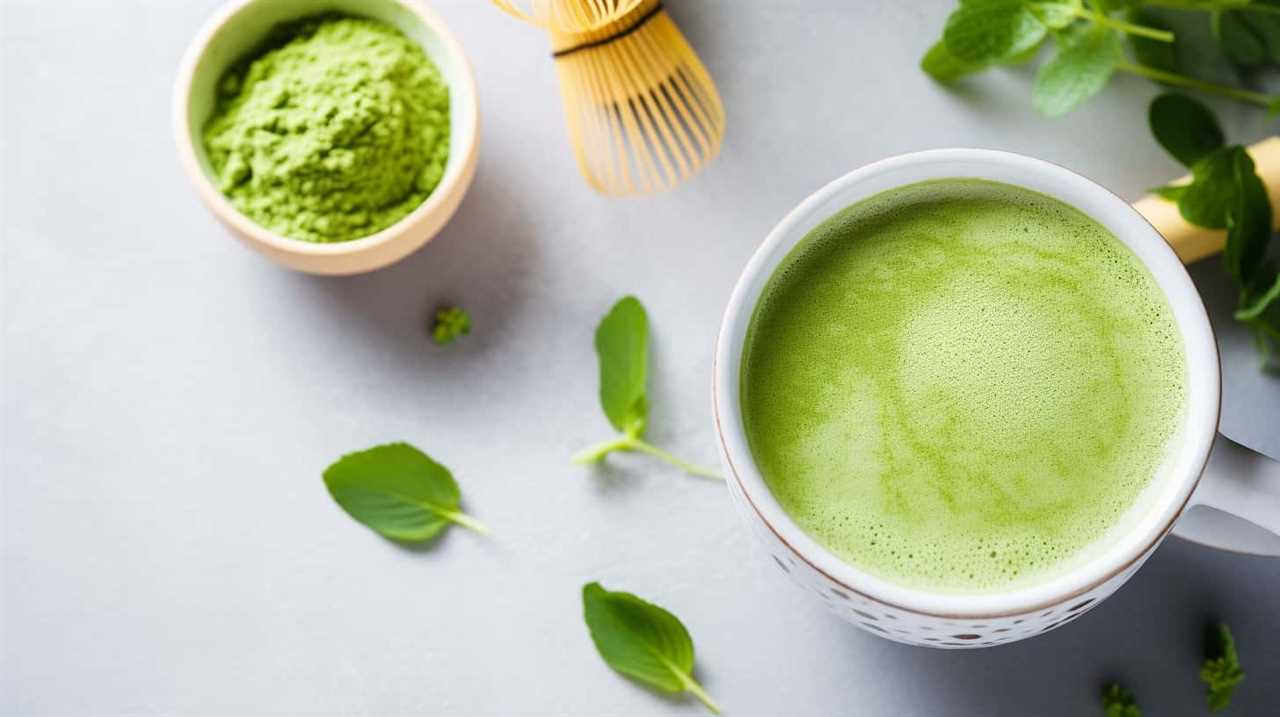
Finally, we add the vanilla extract and mix it in. The vanilla extract enhances the overall flavor of the brownies, adding a subtle aromatic touch.
Step 3: Combining the Dry Ingredients
To combine the dry ingredients for our matcha brownies, we start by sifting the flour and matcha powder together in a separate bowl. Sifting helps to remove any lumps and ensures that the ingredients are evenly distributed. Once the flour and matcha powder are sifted, we can move on to the next step of the recipe.
Here are some tips and techniques to consider when combining the dry ingredients:
- Use a fine-mesh sieve to sift the flour and matcha powder. This will help to create a smoother texture in the brownies.
- Gently tap the sieve to encourage the ingredients to pass through. Avoid pressing or forcing the mixture through, as this can lead to clumps.
- If you don’t have matcha powder on hand, you can try using alternative dry ingredients such as cocoa powder or ground almonds for a different flavor profile.
- Stir the sifted dry ingredients together using a whisk or a spoon. Make sure to mix well to ensure that the matcha powder is evenly distributed throughout the flour.
- Take your time when combining the dry ingredients. Slow and steady mixing will result in a better texture and more uniform flavor.
By following these mixing techniques and considering alternative dry ingredients, you can create matcha brownies that are perfectly balanced and delicious.

Step 4: Adding the Matcha Powder
For this step, we will add the matcha powder to our mixture. Matcha powder is finely ground green tea leaves that offer numerous health benefits. It is rich in antioxidants, which help protect our cells from damage caused by free radicals. Additionally, matcha powder contains a moderate amount of caffeine, providing a gentle energy boost without the jitters commonly associated with coffee.
When choosing matcha powder, it’s important to consider the different grades available. The highest grade, ceremonial grade, is made from young tea leaves and has a vibrant green color. It has a smooth and delicate flavor, perfect for traditional tea ceremonies. Culinary grade matcha, on the other hand, is more suitable for baking and cooking. It has a slightly bitter taste and a darker green color.
To add the matcha powder to our brownie mixture, we will use the following table as a guide:
| Amount of Matcha Powder | Grade | Flavor |
|---|---|---|
| 1 tablespoon | Culinary | Slightly bitter |
| 2 tablespoons | Culinary | Slightly bitter |
| 3 tablespoons | Culinary | Slightly bitter |
| 1 teaspoon | Ceremonial | Smooth and delicate |
Step 5: Folding in the Chocolate Chips
Now that we’ve added the matcha powder, it’s time to take our brownie batter to the next level by folding in the chocolate chips.
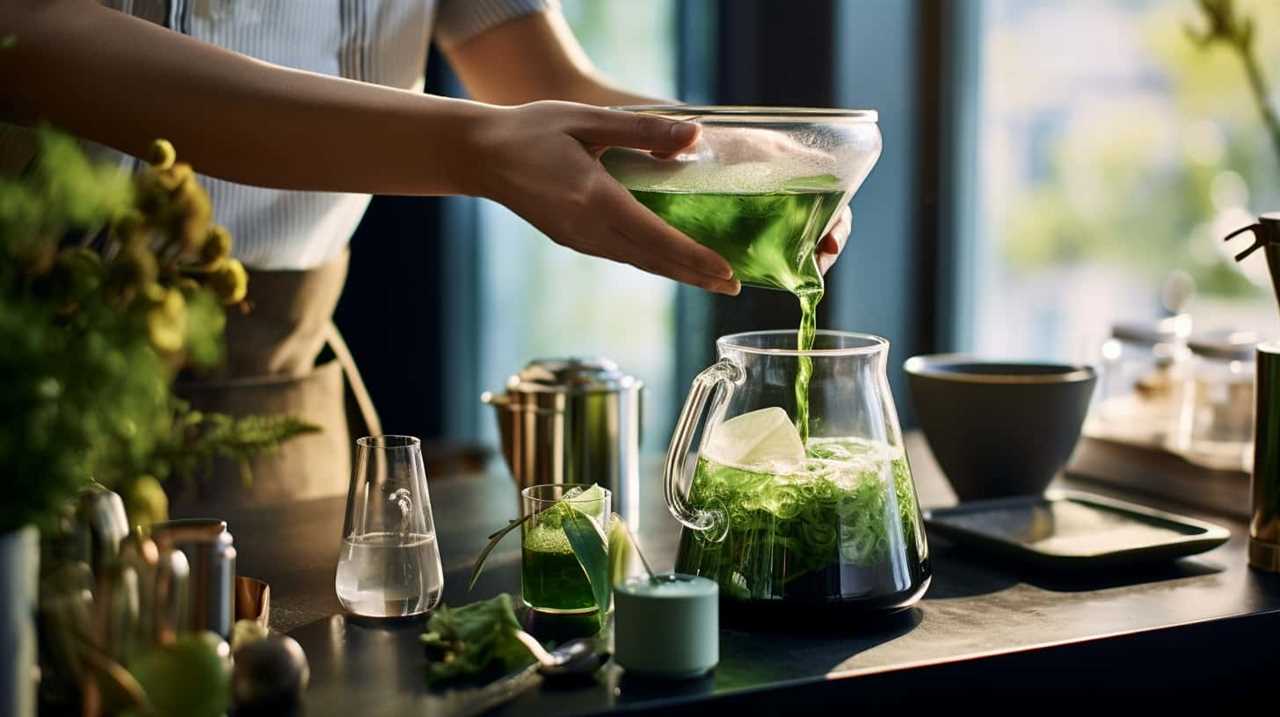
This step is crucial because it ensures an even distribution of chocolate throughout the brownies, ensuring each bite is filled with gooey goodness.
Mixing the Ingredients
We carefully fold in a generous amount of chocolate chips into the matcha brownie batter. This step is crucial in creating the perfect balance between the rich matcha flavor and the decadent chocolate. As we mix the ingredients together, the aroma of the matcha and the sweetness of the chocolate fill the air, creating an irresistible scent.
Here’s what you can expect when folding in the chocolate chips:
- The chocolate chips create pockets of gooey goodness throughout the brownie.
- Each bite is a delightful combination of matcha and melted chocolate.
- The chocolate chips add bursts of sweetness that complement the earthy matcha flavor.
- The brownies have a beautiful marbled appearance, with streaks of melted chocolate running through the green batter.
- The chocolate chips add a satisfying crunch to every bite.
Now that the chocolate chips are folded in, we’re ready to move on to the next step – baking these delectable matcha brownies to perfection. Stay tuned for the baking instructions in the next subtopic!
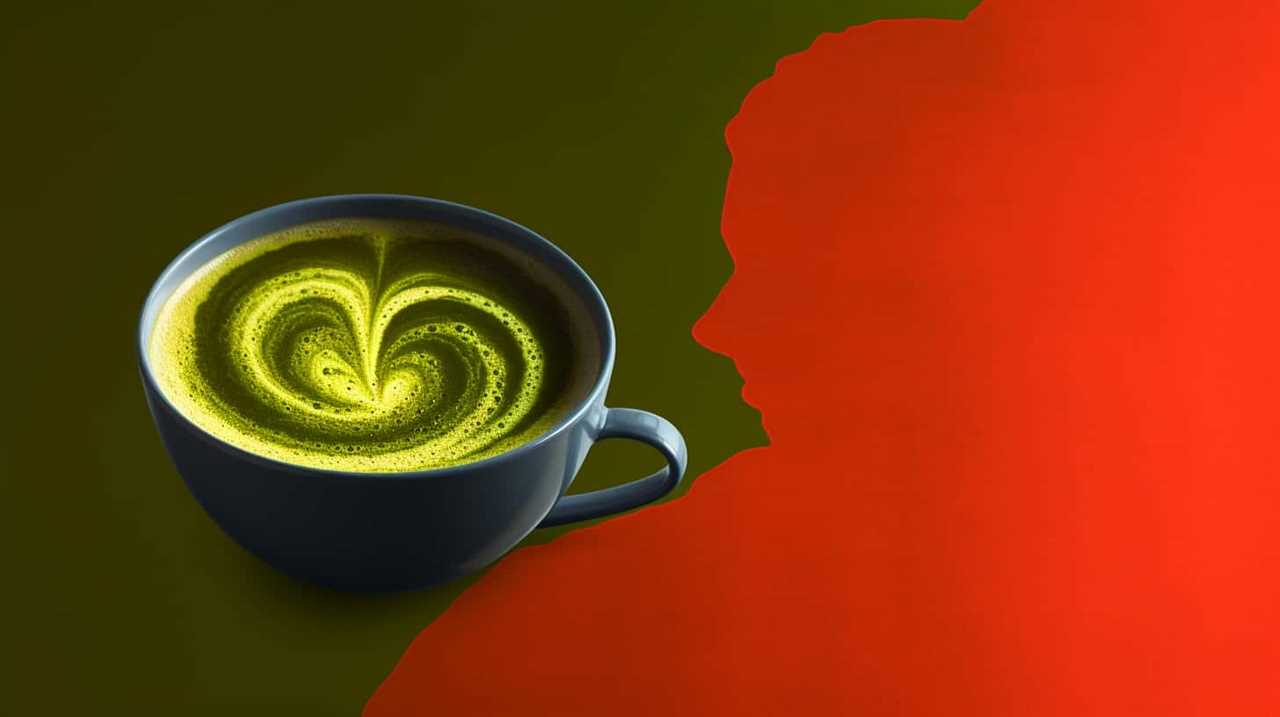
Chocolate Chip Distribution
After carefully mixing the ingredients, we proceed to fold in a generous amount of chocolate chips into the matcha brownie batter. This step is crucial to ensure that every bite is filled with a delightful burst of chocolaty goodness. While traditional chocolate chips are the most common choice, there are other alternatives that can be used to add variety and enhance the flavor profile of the brownies. For those looking for a healthier option, dark chocolate chips or chunks can be used. They provide a richer and slightly bitter taste that pairs well with the earthy matcha flavor. Additionally, the size of the chocolate chips can greatly impact the texture of the brownies. Smaller chips will distribute more evenly throughout the batter, creating a consistent chocolatey experience, while larger chips will create pockets of intense chocolate. Carefully considering the size and type of chocolate chips will result in a perfectly balanced matcha brownie that will delight any dessert lover.
| Chocolate Chip Alternatives | Impact of Chocolate Chip Size |
|---|---|
| Dark chocolate chips or chunks | Smaller chips distribute evenly, creating a consistent chocolatey experience |
| White chocolate chips | Larger chips create pockets of intense chocolate |
| Milk chocolate chips | |
| Mini chocolate chips |
Step 6: Baking the Brownies
To ensure even baking, preheat the oven to 350°F before placing the brownie batter in the baking dish. This step is crucial in achieving the perfect texture and taste for your matcha brownies.
Here are some important points to keep in mind during the baking process:
- Set a timer: Baking time is crucial to avoid undercooking or overcooking the brownies. Set a timer for the recommended baking time and check for doneness with a toothpick inserted into the center. It should come out with a few moist crumbs clinging to it.
- Monitor the oven temperature: Keeping a close eye on the oven temperature is essential for consistent results. Use an oven thermometer to ensure accuracy and make any necessary adjustments.
- Rotate the pan: For even baking, rotate the baking dish halfway through the baking time. This will ensure that the brownies cook evenly on all sides and prevent any hot spots.
- Avoid opening the oven door: Opening the oven door frequently can cause a drop in temperature, affecting the baking time and overall texture of the brownies. Resist the temptation to peek and trust the timer instead.
- Allow for cooling time: Once the brownies are done baking, allow them to cool completely in the baking dish. This will help them set and make it easier to cut into neat squares.
Tips for Achieving the Perfect Texture
To ensure the perfect texture, it’s important to incorporate the right amount of matcha powder into the brownie batter. Achieving a fudgy texture is the goal when making matcha brownies, and there are a few tips that can help you avoid dryness and achieve that deliciously moist result.

Firstly, make sure to measure the matcha powder accurately. Too much matcha can overpower the flavor and make the brownies bitter, while too little may not give you that vibrant green color and subtle matcha taste. Use a kitchen scale or a measuring spoon to get the right amount.
Another tip is to not overmix the batter. Once you’ve added the dry ingredients to the wet ingredients, gently fold everything together until just combined. Overmixing can lead to a tougher texture, so be careful not to overdo it.
Additionally, be mindful of the baking time. Overbaking is a common cause of dry brownies. Keep a close eye on the brownies as they bake and check for doneness by inserting a toothpick into the center. If it comes out with a few moist crumbs, they’re ready to be taken out of the oven. Remember that the brownies will continue to cook slightly as they cool, so it’s better to slightly underbake them than to overbake.
Serving and Storing Your Matcha Brownies
We love to serve and store our matcha brownies in an airtight container to keep them fresh and delicious. Here are some serving tips and storage options to ensure your matcha brownies are enjoyed to the fullest:
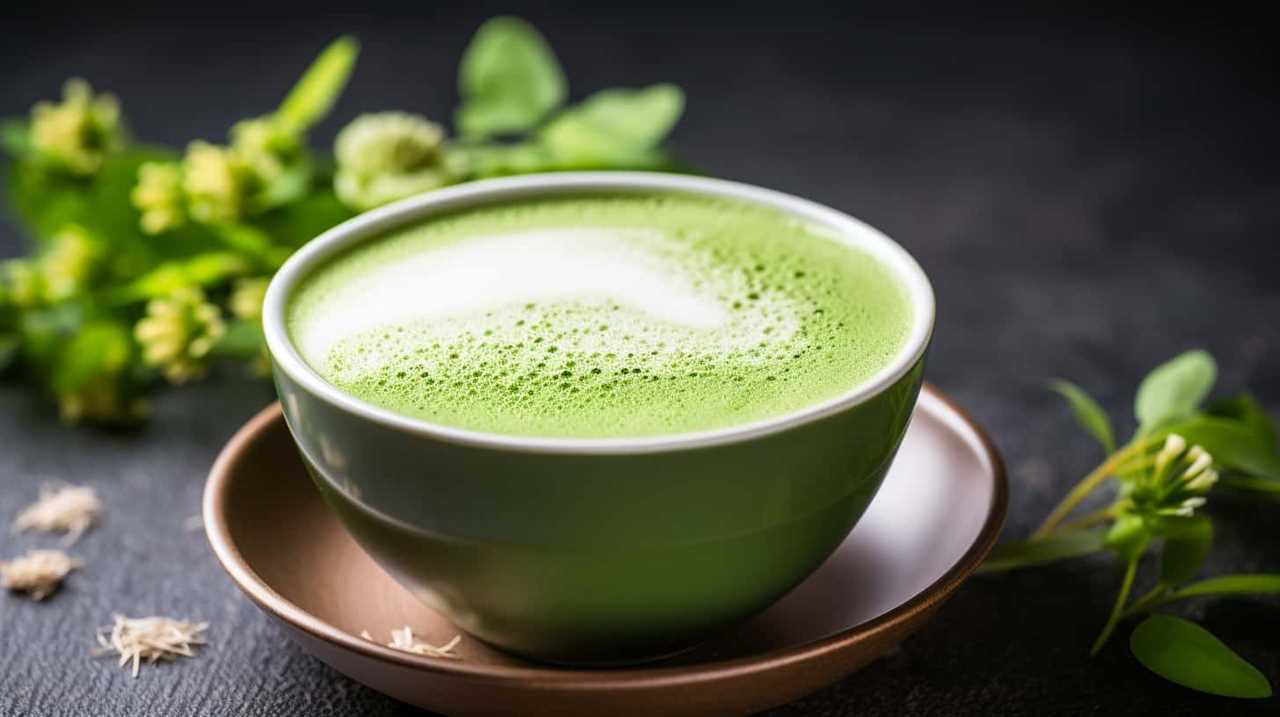
- When serving, cut the brownies into even squares for a professional presentation.
- Dust the top of the brownies with powdered sugar or matcha powder to add an extra touch of elegance.
- For a delightful twist, serve the brownies warm with a scoop of vanilla ice cream or a dollop of whipped cream.
- Pair the matcha brownies with a cup of hot green tea to enhance the flavor and create a harmonious tea time experience.
If you have leftovers, store the brownies in an airtight container to maintain their freshness. They can be stored at room temperature for up to three days or in the refrigerator for up to a week.
Variations and Additional Toppings
There are numerous variations and additional toppings that can be added to elevate the flavor of our matcha brownies. While the classic matcha brownie is delicious on its own, experimenting with different variations and toppings can take it to a whole new level of deliciousness.
One variation to consider is adding white chocolate chips to the batter. The creamy sweetness of the white chocolate complements the earthy flavor of matcha, creating a delightful contrast in every bite.
Another option is incorporating chopped nuts, such as almonds or walnuts, for added texture and crunch.
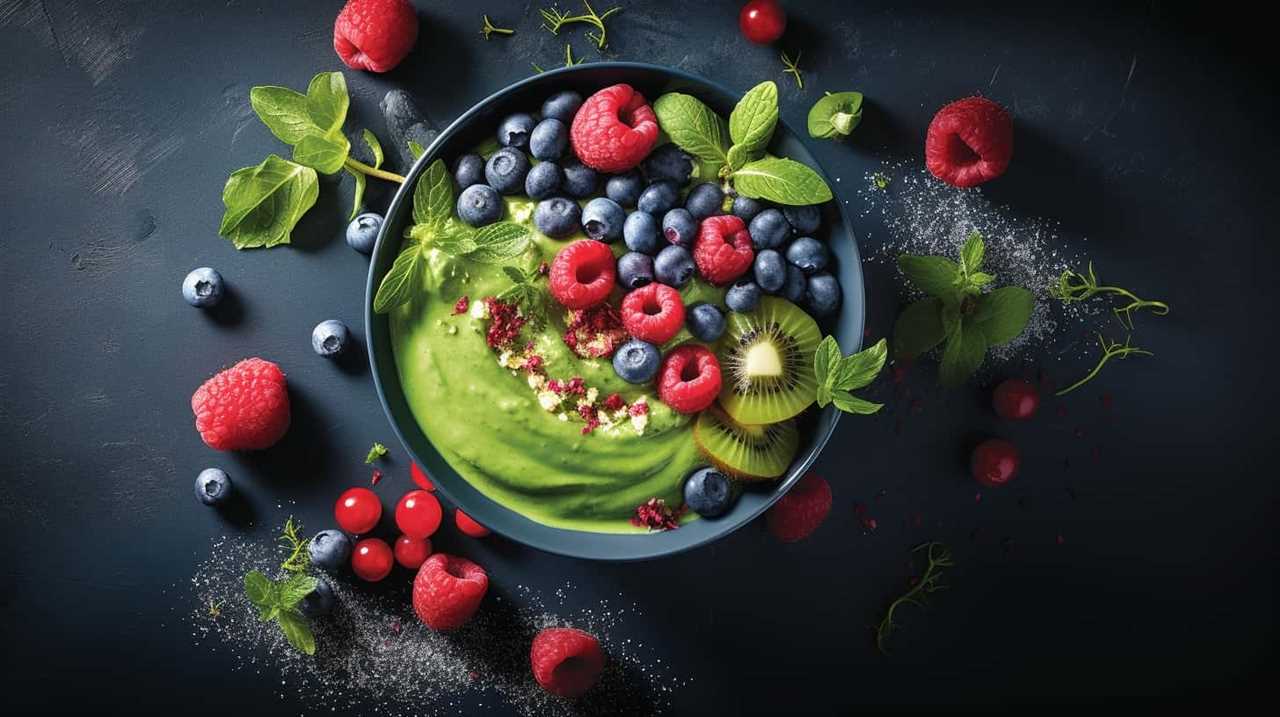
For those who enjoy a touch of fruity freshness, adding dried cranberries or chopped dried apricots to the batter can provide a burst of tanginess that balances out the richness of the brownie. Alternatively, you can top the brownies with a dusting of powdered sugar or a drizzle of melted dark chocolate for an extra touch of indulgence.
If you’re feeling adventurous, consider adding a swirl of peanut butter or Nutella on top of the batter before baking. The combination of these spreads with matcha creates a unique and irresistible flavor profile.
Experimenting with different variations and additional toppings allows you to personalize the matcha brownies to your taste preferences. Whether you prefer something nutty, fruity, or indulgent, there are endless possibilities to explore and create the perfect matcha brownie that will leave everyone wanting more.
Frequently Asked Questions
Can I Substitute Regular Flour for Matcha Powder in the Brownie Recipe?
Sure, you can substitute matcha powder for regular flour in the brownie recipe. It adds a unique flavor and vibrant green color. However, since matcha is more dense, you might need to adjust the proportions and add some liquid.

How Long Do Matcha Brownies Typically Last Before They Go Bad?
Matcha brownies typically last for about 3-4 days before they go bad. To extend their shelf life, store them in an airtight container at room temperature. Enjoy these delightful treats while they’re fresh!
Can I Use Any Type of Chocolate Chips in the Brownie Recipe?
Yes, you can definitely use different types of chocolate chips in the brownie recipe. It all comes down to personal preference. Choose the best chocolate chips that complement the flavors of the brownies.
Are There Any Specific Health Benefits of Matcha That Are Enhanced When Used in Brownies?
When it comes to matcha, the health benefits are undeniable. But did you know that when used in brownies, these benefits are enhanced? Discover the culinary uses that make matcha a true superfood!
Can I Add Nuts or Other Mix-Ins to the Matcha Brownie Recipe?
Yes, you can definitely add nuts or other mix-ins to the matcha brownie recipe. Some popular mix-ins for matcha brownies include walnuts, chocolate chips, and dried cranberries. They add extra texture and flavor to the delicious treat.

Conclusion
In conclusion, these matcha brownies are a delicious and healthy treat that you can enjoy guilt-free. The matcha powder not only adds a vibrant green color but also provides numerous health benefits, including boosting metabolism and enhancing concentration.
Did you know that matcha contains 137 times more antioxidants than regular green tea? So not only will you satisfy your sweet tooth with these brownies, but you’ll also be nourishing your body with a powerful antioxidant boost.
Justin is a seasoned author, coffee and tea enthusiast, and an essential member of the Cappuccino Oracle team. With a keen appreciation for the complexities of coffee, coffee alternatives, and tea, Justin has dedicated his professional career to exploring these realms and sharing his insights with readers worldwide.
Justin’s immersion in the world of coffee, coffee alternatives, and tea began at a young age, kindling a passion that extended beyond mere consumption. This love for these beverages led him to combine his talent for writing with his devotion to coffee and tea, bringing him to Cappuccino Oracle as a dedicated author.
Matcha
Unveiling The Mysteries Of Matcha: Insights On Its Origins, Production, And Quality

Have you ever been curious about the mysteries behind the rich and natural flavors of matcha? If so, get ready to join me on an adventure as we uncover the secrets of matcha, delving into its origins, production, and quality.
As a lover of all things tea, I have delved deep into the world of matcha, immersing myself in its rich history and intricate production process. From the shade-grown tea leaves to the meticulous grinding technique, every step is a labor of love that culminates in the velvety smooth powder we know as matcha.
Join me as we unravel the secrets behind this ancient Japanese tradition and discover why quality is key when indulging in this verdant elixir. We’ll explore the nuances of flavor, the importance of sourcing, and even delve into the fascinating world of other tea varieties.
So grab a cup, sit back, and let’s dive into the captivating world of matcha.
Key Takeaways
- Matcha tea is made from powdered green tea leaves and has a long and labor-intensive production process.
- Premium matcha is made from the first harvest in early spring, using the top 3 sprouts of the tea plant and ground tencha leaves.
- Cheaper matchas may skip some steps in the production process and are more suitable for matcha lattes.
- High-quality matcha is recommended for sparing consumption, as it has a smoother flavor and more health benefits compared to cheaper matchas.
What is matcha?
I’ve learned that matcha is a powdered green tea made from special tea leaves that are shaded before harvest, and it has a long and labor-intensive production process.
There are different types of matcha available, but the premium matcha is made from the first harvest in early spring, using only the top 3 sprouts of the tea plant. The leaves are then steamed, dried, and have their stems removed before being ground into a fine powder using a specialized mill made of granite.
It’s important to note that high-quality matcha is recommended for sparing consumption, as it has a complex production process that results in a smooth flavor. Matcha also offers various health benefits, such as being rich in antioxidants, boosting metabolism, and improving mental alertness.
Production process
The matcha production process involves shading the tea leaves before harvest and selecting the top three sprouts of the tea plant for premium matcha. Shading is a technique used to enhance the flavor and quality of the tea leaves. By covering the tea plants with shade, the leaves produce more chlorophyll and amino acids, resulting in a vibrant green color and a rich, umami taste.
After the shading period, only the top three sprouts of the tea plant are carefully handpicked for premium matcha. These selected leaves, known as tencha leaves, are then steamed, dried, and have their stems removed.
Finally, the tencha leaves are ground into a fine powder using a specialized granite mill. This process results in the smooth and concentrated matcha powder that we enjoy.
Quality and consumption
Let me tell you, indulging in high-quality matcha is like sipping a vibrant green elixir that awakens your taste buds and nourishes your body with its rich flavor and numerous health benefits. Matcha’s health benefits are truly remarkable. Packed with antioxidants, vitamins, and minerals, matcha is known to boost metabolism, enhance focus and concentration, and strengthen the immune system.
But not all matcha is created equal. Different grades of matcha exist, ranging from ceremonial grade to culinary grade. Ceremonial grade matcha is made from the highest quality tencha leaves and has a smooth, vibrant green color and a delicate, umami flavor. It is best enjoyed on its own, whisked with hot water.
On the other hand, culinary grade matcha is more affordable and is suitable for making matcha lattes, smoothies, and baked goods. Although it may have a slightly bitter taste and a duller color, it still provides health benefits.
So, whether you choose to indulge in high-quality ceremonial grade matcha or opt for the more affordable culinary grade, incorporating matcha into your routine is a delicious way to reap its health benefits.
Frequently Asked Questions
What are some popular ways to enjoy matcha besides drinking it as tea?
Besides drinking matcha as tea, some popular ways to enjoy it include indulging in matcha desserts like matcha ice cream, matcha cake, and matcha cookies. Additionally, matcha smoothies are a refreshing and healthy option.
Are there any specific health benefits associated with consuming matcha?
I’m no expert, but matcha is said to have potential health benefits. Some claim it can aid in weight loss due to its high antioxidant content and metabolism-boosting properties. However, more research is needed to confirm these claims.
How does the quality of matcha affect its flavor and overall experience?
The quality of matcha directly affects its flavor and overall experience. Higher quality matcha, made from carefully selected leaves and processed with precision, offers a smoother and more vibrant flavor, while lower quality matcha may have a less appealing taste and color.
Can matcha be used in cooking or baking?
"Where there’s matcha, there’s a way! Matcha can be used in a variety of cooking and baking recipes, adding a vibrant green color and a unique earthy flavor to dishes like matcha desserts."
Are there any specific tips or techniques for properly preparing matcha tea at home?
To properly prepare matcha tea at home, start by sifting the matcha powder to remove any clumps. Then, choose water at around 175°F to 180°F for the best flavor. Gradually add water to the matcha and whisk in a "W" or "M" motion until frothy. Enjoy!
Conclusion
In conclusion, matcha tea is not just a beverage, but a rich and fascinating tradition that has evolved over centuries.
From its origins in Japan to its intricate production process, matcha is a labor of love.
The quality of matcha is crucial, as the steps taken in its production directly impact its flavor and aroma.
Whether you’re a matcha connoisseur or a beginner, there is a matcha tea out there for you.
So, why not indulge in a cup of this vibrant green elixir and experience the magic of matcha for yourself? It’s a journey worth embarking on!
Arf, an author and an innovative enthusiast of coffee, coffee alternatives, and tea, plays a crucial role as a contributor to the esteemed Cappuccino Oracle platform. Renowned for his curiosity and passion for these captivating beverages, Arf has carved out a unique space for himself in the world of exploration and writing. He realized that coffee, coffee alternatives, and tea are not mere drinks to keep one awake, but universes of flavors and stories waiting to be explored.
Arf’s articles for Cappuccino Oracle blend meticulous research with personal experiences, providing readers with an in-depth understanding of various types of coffee, coffee alternatives, and tea, along with their unique characteristics, cultures, and histories. His honest reviews and engaging narratives guide readers on their own journeys, helping them discover their preferences and find their perfect brew.
Matcha
Unveiling The Truth Behind Starbucks’ Matcha: A Disappointing Blend

Being a lover of tea, I was eager to sample Starbucks’ matcha beverages, anticipating a flavorful and genuine taste. However, to my dismay, I found that it was a subpar mixture of inexpensive green tea powder and an excessive amount of sugar. This was a stark contrast to the customary matcha experience that I had grown accustomed to.
The use of low-quality matcha by Starbucks is driven by the need for mass production and a consistent taste across all locations. But in this pursuit, they have sacrificed the true essence of matcha. Authentic matcha production involves meticulous steps to ensure a high-quality and flavorful product, steps that Starbucks seems to skip.
The result is a matcha latte packed with 32 grams of sugar, equivalent to a can of soda, and a whopping 240 calories. It’s time to unveil the truth behind Starbucks’ matcha and explore better options for a truly satisfying tea experience.
Key Takeaways
- Starbucks uses a cheap green tea powder for their matcha drinks, which may not even be considered matcha.
- The cheap matcha powder is mixed with a lot of sugar, negating the health benefits and undermining the quality of the tea.
- Starbucks’ matcha latte contains a high amount of sugar, similar to a can of soda, and has a significant number of calories.
- To have a better matcha experience, it is recommended to explore premium, first harvest matcha made by talented farmers in Japan and to try different matcha options to find preferred taste.
What is Starbucks Matcha?
Starbucks Matcha is a cheap green tea powder mixed with a high amount of sugar, which not only undermines the health benefits of matcha but also fails to deliver the natural, great-tasting flavor of authentic matcha tea.
The ingredients used in Starbucks matcha include low-quality green tea powder that is likely produced on a large scale. Unlike traditional matcha production methods, Starbucks skips certain steps to save time and money. These steps, such as shading the tea plants to reduce bitterness and selecting the top leaves for their flavor and nutrients, are crucial in creating high-quality matcha.
Instead, Starbucks opts for a blend of cheap green tea powder mixed with sugar, resulting in a dull and bitter flavor. This disappointing blend of ingredients does not live up to the standards of true matcha tea.
Quality vs. Cheap Matcha
Indulging in high-quality matcha is like savoring a delicate melody that dances on your taste buds, while settling for cheap matcha is akin to a discordant symphony that leaves a bitter aftertaste. When it comes to matcha, quality matters. Traditional matcha production is an art that requires time, patience, and attention to detail. The importance of shading the tea plants, selecting the top leaves, and using a stone mill to grind the leaves into a fine powder cannot be overstated. These steps not only enhance the flavor but also preserve the health benefits of matcha. High-quality matcha is rich in antioxidants, boosts metabolism, and promotes a sense of calm. On the other hand, cheap matcha often lacks these qualities as it skips crucial steps and is mixed with sugar and other additives. Don’t settle for a subpar matcha experience; choose high-quality matcha for its exceptional taste and health benefits.
| Traditional Matcha Production |
|---|
| Shading the tea plants |
| Selecting the top leaves |
| Grinding with a stone mill |
The importance of traditional matcha production cannot be overstated. These steps not only enhance the flavor but also preserve the health benefits of matcha. High-quality matcha is rich in antioxidants, boosts metabolism, and promotes a sense of calm. On the other hand, cheap matcha often lacks these qualities as it skips crucial steps and is mixed with sugar and other additives. Don’t settle for a subpar matcha experience; choose high-quality matcha for its exceptional taste and health benefits.
Recommendations for Better Matcha
Exploring different matcha options can lead to a better matcha experience. When it comes to matcha, not all options are created equal. While Starbucks may offer a convenient matcha latte, there are alternative options that provide a more authentic and higher quality experience.
Premium matcha, specifically first harvest matcha, is made by talented farmers in Japan and can be enjoyed plain, without the need for excessive sugar or additives. By choosing premium matcha, you can reap the full benefits that matcha has to offer, such as its high antioxidant content and potential health benefits.
Additionally, exploring different types of matcha, such as Japanese black tea, can expand your taste palate and introduce you to new and exciting flavors. So, why settle for a disappointing blend when there are better matcha options out there waiting to be explored?
Frequently Asked Questions
How is Starbucks matcha different from traditional matcha?
Starbucks matcha differs from traditional matcha in terms of quality and taste. One interesting statistic is that Starbucks’ matcha latte contains 32 grams of sugar, similar to a can of soda, which undermines the health benefits of matcha.
What are the health benefits of matcha and how do they differ between Starbucks matcha and premium matcha?
The health benefits of matcha include high levels of antioxidants, increased energy, and improved focus. However, Starbucks matcha quality is compromised due to the use of cheap powder mixed with sugar, negating these benefits.
Can you customize the sweetness level of Starbucks matcha drinks?
Yes, you can customize the sweetness level of Starbucks matcha drinks. They offer popular matcha drink variations like matcha latte and matcha frappuccino, allowing customers to choose the amount of sweetener they prefer.
Are there any alternative options for matcha drinks at Starbucks?
Yes, there are alternative options for matcha drinks at Starbucks. However, it’s important to note that the taste may not be comparable to traditional matcha. Exploring different matcha options and Japanese black tea can provide a better experience.
What are the steps involved in producing high-quality matcha and how does Starbucks’ matcha production differ?
Starbucks’ matcha production process differs from traditional matcha production in Japan. High-quality matcha involves shading the tea plants, selecting the top leaves, steaming, drying, and grinding them. However, Starbucks skips these steps, resulting in a lower quality and less authentic matcha experience.
Conclusion
In conclusion, after delving into the truth behind Starbucks’ matcha, it’s clear that their blend falls short of expectations. The use of cheap green tea powder mixed with excessive sugar dilutes any potential health benefits and fails to deliver an authentic matcha experience.
To truly enjoy the rich and flavorful taste of matcha, it’s recommended to explore premium, first harvest options crafted by skilled Japanese farmers. Don’t settle for subpar matcha; treat yourself to a tea experience that’ll leave your taste buds dancing with delight.
Arf, an author and an innovative enthusiast of coffee, coffee alternatives, and tea, plays a crucial role as a contributor to the esteemed Cappuccino Oracle platform. Renowned for his curiosity and passion for these captivating beverages, Arf has carved out a unique space for himself in the world of exploration and writing. He realized that coffee, coffee alternatives, and tea are not mere drinks to keep one awake, but universes of flavors and stories waiting to be explored.
Arf’s articles for Cappuccino Oracle blend meticulous research with personal experiences, providing readers with an in-depth understanding of various types of coffee, coffee alternatives, and tea, along with their unique characteristics, cultures, and histories. His honest reviews and engaging narratives guide readers on their own journeys, helping them discover their preferences and find their perfect brew.
Matcha
The Ultimate Guide To Using Chashaku: Your Matcha Essential

Being a lover of matcha, I am aware that the crucial factor in achieving the perfect matcha bowl is the equipment we utilize. When it comes to preparing matcha, there is one tool that is particularly essential: the chashaku.
This bamboo spoon, with its elegant design and precise measurements, is the secret weapon of matcha lovers worldwide. In this ultimate guide, I will take you on a journey through the history and evolution of the chashaku, and show you how to use it like a pro.
From its origins as a metal or ivory scoop to its modern-day incarnation in bamboo, the chashaku has come a long way. With its 48° bend and 18mm length, it effortlessly scoops the perfect amount of matcha from its container.
So grab your chashaku and get ready to elevate your matcha game to new heights. Let’s dive in and discover the wonders of this matcha essential.
Key Takeaways
- Chashaku is a bamboo spoon used to scoop matcha powder in the Japanese tea ceremony and by matcha lovers worldwide.
- Chashaku is one of the three important tea utensils used in the tea ceremony and is about 18mm in length with a 48° bend at the end for scooping.
- Chashaku is made of bamboo to avoid negative reactions with matcha powder and is a great measurement tool for matcha powder.
- Two scoops of chashaku is the standard amount for a bowl of matcha tea, and it is easy to maneuver in matcha tins or natsume due to its small size.
What is Chashaku?
Chashaku is a bamboo spoon used to scoop matcha powder, and it’s one of the three important tea utensils used in the Japanese tea ceremony.
Made from a single piece of bamboo, this elegant tool has a long history dating back to the Muromachi period in Japan. Originally crafted from metal or ivory, chashaku evolved to be made of bamboo due to its natural properties and to avoid any negative reactions with matcha powder.
The design of chashaku is both functional and beautiful, with a length of about 18mm and a 48° bend at the end for easy scooping. There are different styles of chashaku scoops, each with its own unique shape and characteristics. The back of the chashaku has a rough texture, while the face is smooth and sleek.
Whether you’re a matcha lover or a tea ceremony enthusiast, using a chashaku adds a touch of authenticity and tradition to your matcha preparation.
History and Evolution
During the Muromachi period in Japan, the chashaku spoon evolved from being made of metal or ivory to its current bamboo form, which is about 18mm in length and has a 48° bend at the end for easier scooping. The history and evolution of the chashaku is a testament to its significance in Japanese tea ceremonies and its cultural importance in matcha preparation.
| The significance of chashaku in Japanese tea ceremonies | The cultural importance of chashaku in matcha preparation |
|---|---|
| Chashaku is one of the three important tea utensils used in the tea ceremony. | Chashaku is a great measurement tool for matcha powder. |
| Chashaku originated in Japan during the Muromachi period. | Chashaku’s small size allows for easy maneuvering in matcha tins or natsume. |
| Originally made of metal or ivory, chashaku evolved to be made of bamboo. | Chashaku is made from a single piece of bamboo and shaped with a bend for the scoop. |
| Chashaku is made of bamboo to avoid negative reactions with matcha powder. | The back of chashaku has a rough texture, while the face is smooth and sleek. |
The chashaku’s role in Japanese tea ceremonies cannot be understated. It is one of the three essential utensils used in the tea ceremony, alongside the chawan (tea bowl) and chasen (tea whisk). The chashaku’s small size and precise measurement make it the perfect tool for scooping matcha powder. Its evolution from metal or ivory to bamboo shows the cultural importance placed on this utensil. The chashaku’s design, with its gentle bend and smooth face, allows for easy and graceful scooping of matcha. Using the chashaku is not only practical but also a way to honor the centuries-old tradition of matcha preparation.
How to Use Chashaku
To use the chashaku, I simply hold it like a pencil and dip the scoop into the matcha container. Then, I carefully lift the chashaku scoop out and place it over the matcha bowl to dump the powder.
It’s a simple and elegant technique that ensures the perfect amount of matcha every time.
But did you know that there are alternative ways to use the chashaku? Some matcha lovers prefer to use a teaspoon or a regular spoon to scoop their matcha powder. While these alternatives may work in a pinch, they don’t offer the same precision and authenticity as the chashaku.
The chashaku’s unique design and size make it the ideal tool for measuring matcha powder. Plus, using the chashaku adds a traditional touch to the matcha preparation process, enhancing the overall experience.
So why settle for anything less? Embrace the chashaku and elevate your matcha game to the next level.
Frequently Asked Questions
What are the different types of materials used to make chashaku besides bamboo?
There’s something truly magical about the chashaku, the bamboo spoon that gracefully scoops matcha powder. While bamboo is the traditional material, chashaku can also be made from metal or ivory, although these alternatives are less common.
Can chashaku be used to scoop other powders besides matcha?
Yes, chashaku can be used to scoop other powders besides matcha. However, it is primarily designed for scooping matcha powder and is most commonly used in Japanese tea ceremonies. To properly clean and care for a chashaku, it is recommended to wipe it with a dry towel or tissue to avoid water damage. The chashaku is a versatile tool with different uses in the tea ceremony, making it an essential item for matcha lovers.
How long does a chashaku typically last before it needs to be replaced?
A chashaku typically lasts for a long time, but the lifespan can vary depending on the material. Bamboo chashaku is the most common and durable option, while metal or ivory may wear down over time. Proper care involves cleaning with a dry towel or tissue to avoid water damage.
Can chashaku be used with different types of matcha bowls or is it specific to a certain style?
Absolutely! Chashaku can be used with various types of matcha bowls, adapting to different styles. Its small size and unique design make it perfect for scooping matcha powder and adding a touch of elegance to your matcha preparation.
Are there any alternative utensils that can be used in place of chashaku for scooping matcha powder?
Yes, there are alternative utensils for scooping matcha powder, such as a teaspoon or a small spoon. However, using a chashaku has its benefits. Its unique design allows for precise measurements and easy maneuvering in matcha tins.
Conclusion
In conclusion, using chashaku isn’t just a practical way to measure and scoop matcha powder, but it’s also an essential tool for embracing the art and tradition of the Japanese tea ceremony.
While some may argue that using a regular spoon can achieve the same result, chashaku offers a unique experience that connects us to centuries of tea culture. Imagine holding the slender bamboo spoon, feeling the weight of tradition in your hand, and delicately scooping the vibrant green matcha powder.
It’s a sensory journey that brings us closer to the beauty and mindfulness of matcha preparation. So, embrace the chashaku, and let it elevate your matcha experience to new heights.
Arf, an author and an innovative enthusiast of coffee, coffee alternatives, and tea, plays a crucial role as a contributor to the esteemed Cappuccino Oracle platform. Renowned for his curiosity and passion for these captivating beverages, Arf has carved out a unique space for himself in the world of exploration and writing. He realized that coffee, coffee alternatives, and tea are not mere drinks to keep one awake, but universes of flavors and stories waiting to be explored.
Arf’s articles for Cappuccino Oracle blend meticulous research with personal experiences, providing readers with an in-depth understanding of various types of coffee, coffee alternatives, and tea, along with their unique characteristics, cultures, and histories. His honest reviews and engaging narratives guide readers on their own journeys, helping them discover their preferences and find their perfect brew.
-

 Americano3 weeks ago
Americano3 weeks agoHow to Make Americano With Moka Pot
-

 Americano4 weeks ago
Americano4 weeks agoHow to Make an Americano in a French Press
-

 Americano5 days ago
Americano5 days agoHow to Make Korean Iced Americano
-

 Americano3 weeks ago
Americano3 weeks agoHow to Make Iced Americano With Instant Coffee
-

 Americano3 weeks ago
Americano3 weeks agoWhat to Add to an Americano at Starbucks
-

 Americano4 weeks ago
Americano4 weeks agoHow to Make Americano With a Nespresso Machine
-

 Americano2 weeks ago
Americano2 weeks agoHow to Make Americano With Bialetti
-

 Americano3 weeks ago
Americano3 weeks agoHow to Make Dutch Bros Americano










